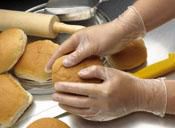Digital food safety is the future of meeting standards. By using the right technology, you can achieve the highest possible inspection scores as well as drive operational efficiency. So what are the advantages of converting your food safety system to a completely digital process? Let’s explore the options for the food industry, from the production level to the retail and restaurant industries.
What is digital food safety?
Digital food safety uses the latest technology to digitise food safety practices that would otherwise be done manually, usually into a centralised software solution. Analog food safety systems often leave room for human error that could be potentially dangerous for the food business and the consumer. Here are some of the industries that could benefit from digital food safety technology:
- Restaurants and catering
- Food production
- Beverage industry
- Bread manufacturing
- Baking industry
- Supermarkets
- Fast-food restaurants
- Confectionery industry
- Poultry
- Meat and seafood industry
- Logistics
- Warehousing
- Food auditing
Each of these industries has the potential to handle food and adhere to the strict standards set by Food Standards Australia New Zealand (FSANZ), set to protect the consumer from illness that could potentially be contracted through food poisoning. For example, Testo’s equipment can log data, measure temperature, pressure and humidity on a continuous and reliable basis.
Why is digital food safety important?
As previously mentioned, any industry that handles food in some capacity would benefit from digital food safety technology. While many businesses may have gotten away with using some analog systems, the quick-paced nature of most food-related industries requires digital technology to keep up and meet the newest standards set by the Australian government. So what happens if these standards are not met? The company will score low during its inspections and, worst of all, potentially cause harm to the consumer. The negative impacts of poor food safety compliance include serious illnesses.
Food poisoning
This type of illness is caused by bacteria that were allowed to grow on food due to poor preparation, storage or cooking. According to Food Safety Information Council, “There are an estimated 4.1 million cases of food poisoning in Australia each year that result in 31,920 hospitalisations, 86 deaths and 1 million visits to doctors on average each year.”
Aside from preventing potential sickness to the consumer or worker, there are many other benefits to be had from digital food safety. For example, upgrading your systems can drive operational efficiency in restaurants and other food businesses. The cold chain, for instance, benefits greatly from Testo’s measuring instruments for the storage and transport of incoming goods.
What food safety regulations are there?
Australian food safety regulations are put in place to set a standard that protects the consumer and worker alike from foodborne illness. Compliance with these regulations is a must for every participant in the food sector. Here are some of the most important components of food safety standards in Australia, according to FSANZ. Many of these regulations are tested by Hazard Analysis and Critical Control Points (HACCP).
2-hour / 4-hour rule
This is a good rule to follow to ensure that food that has been removed from refrigeration remains safe. Keep in mind that this rule revolves around the growth of microorganisms in food at temperatures between 5°C and 60°C. According to the FSANZ website, this is how it works:
- Food held between 5°C and 60°C for less than two hours can be used, sold or put back in the refrigerator to use later.
- Food held between 5°C and 60°C for two to four hours can still be used or sold, but can’t be put back in the fridge.
- Food held between 5°C and 60°C for four hours or more must be thrown away.
Temperature
Particular food needs to be kept at the right temperature, something Testo’s systems can track and log. Meat products, fruits and vegetables, dairy products or eggs are all items that are subject to strict temperature control. If they are not kept at a stable and precise temperature, dangerous microorganisms can grow.
Storage
Standard 3.2.2 of the Food Safety Practices and General Requirements guide addresses the standards for food storage. The guidelines urge companies to “store potentially hazardous food at 5°C or colder.” Be sure to check that the food packaging is undamaged because it could compromise the quality.
To learn more about food safety regulations and standards, check out the FSANZ website or download Testo’s Pocket-Guide Food Safety now.
What is the best technology for digital food safety?
As a leader in your industry, you want tools that will help increase the efficiency and effectiveness of your digital food safety system. Testo knows better than most about the importance of reliable and top-of-the-line technology in smarter food safety. Testo offers many different products to meet a variety of needs, but here are a few examples of digital food safety tools that make all the difference in passing inspections and producing a quality product:
- Temperature monitoring: Control the climate, and ensure compliance with HACCP and EN 12830 guidelines.
- pH measurement: Tools that measure pH alert the user when the value is at a dangerous level, one that encourages bad microbial growth.
- Sterilisation, pasteurisation and freeze drying: Technology that validates these processes is standard compliant and is necessary to ensure that the regulations are met, encouraging a higher quality product.
To learn more about how you can elevate your digital food safety systems, reach out to Testo today and be sure to catch up on the Testo blog.









 Reduce cooking oil costs while ensuring quality
Reduce cooking oil costs while ensuring quality Expert knowledge on CO2 monitoring
Expert knowledge on CO2 monitoring Refrigeration knowledge - in 3 modules
Refrigeration knowledge - in 3 modules



